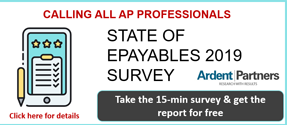I recently had the opportunity to connect with Chauncey St. John, Senior Customs Operations Manager and former Global Process Leader Healthcare, Source-to-Pay, GE Global Operations USA, about designing, pitching, and executing an eInvoicing strategy. Chauncey will be giving a session on this topic on May 14th at the Exchange Summit Conference in Miami and I thought this would be a great opportunity for our user community to hear about his eInvoicing experiences and learnings over the past five years at GE.
Bob Cohen: Thank you for taking the time to connect with me to discuss your E-Invoicing experiences at GE. Let’s get started with some information on you and your background as well as an overview of the history of GE Global Operations.
Chauncey St. John: I started with GE in their Schenectady, NY Power campus, contracted out as a finance analyst in 2009. I was part of an early GE accounts payable shared service team supporting the Energy businesses (Power, O&G, Renewables, etc). I ended up leading that operations team for a couple years before taking my first GE role in project implementations.
I progressed within that project organization, rolling out Optical Character Recognition (OCR) technology & eInvoicing globally along with other toolkit items and process standards. Around 2014, GE created Global Operations as their official Global Business Service and I accepted a promotion in 2015 to move to the Cincinnati hub as a project simplification leader.
Our shared service team became the gold standard for what is now deemed Source-to-Pay (S2P) and allowed us to grow from 15 GE employees to many hundred. This gave me the chance to interview, train & ultimately mentor many great teammates around the world. Across those roles, GE granted me the opportunity to travel to over 15 countries and all the major Global Ops hubs, experiencing a wide variety of cultures.
Most recently I’ve served as S2P Global Process Leader for GE Healthcare, helping marry many of the best practices from the Energy side with the more demanding Healthcare requirements while widely expanding their technology toolkit.
BC: What went into the ‘design’ of your S2P toolkit and what did it include?
CSJ: Looking across the Source-to-Pay lifecycle, there are many opportunities for technology to provide step-change improvements. There is also a sprawling landscape of technology options. This leads to a daunting challenge of first prioritizing what you want to accomplish, and then selecting the right tool. The S2P Toolkit provides a comprehensive set of options depending on the business priorities, so you don’t end up using a hammer to fix a leak.
The toolkit is broken up based on the outcome you’re trying to achieve. Our core priority is focused on the invoice source and trying to eliminate paper via eInvoicing portals, interfaces, and self-billing (Evaluated Receipt Settlement also known as ERS) processes. Where paper cannot be eliminated, we seek to streamline with OCR. However, other sections of the toolkit focus on elements such as cash, including a trade financing program for discount capture as well as a pay term start date optimization program.
BC: How did you ‘pitch’ the project to management? What was included and how was it received?
CSJ: You cannot underestimate the importance of pitching these types of projects correctly. As much as the benefits may feel self-evident, you must keep in mind that global business services (or the oft-maligned term “shared service”) are still an afterthought to most supply chain organizations. There are two strategies I would suggest here:
The first sounds basic, but you must speak in dollars. CEO’s don’t care that you’re saving their buyers 5 min of work or streamlining/automating a process. They care what that translates to in savings. To that end, we’ve developed a cost-per-invoice model where you plug in transactional invoice data that will assign costs based on transaction type/history and lines up closely with the actual S2P cost liquidation per business. For example, paper invoices cost $5 whereas ERS invoices cost $0.85. Further adders/subtractors then take into account holds and other criteria beyond invoice source. The end result reflects the actual AP processing costs and provides a clear financial picture. Now you can go to the CEO and explain how the ERS program converting 100,000 invoices from paper will save over $400K.
The second is to know your audience. A CEO caring about the financial bottom line is obvious, but your sales pitch does not start or end there. What about the strategic sourcing leader? How about the plant managers? Did you consider the buyers? Take an eInvoicing platform as an example. The sourcing leader may care most about the cash advantage of pushing out payment start terms through upfront invoicing controls (e.g. no invoice prior to PO/receipt). The plant manager may care about improved fulfillment due to better pay on time rates. The buyer may care about the hold elimination & invoice status inquiry elimination. If you don’t sell them all from the bottom up, you will not fully succeed.
BC: What lessons were learned during implementation, roll-out, and use of this project?
CSJ: How much space do we have for this interview? I’ll go back to GE’s founder Edison on this one: “I have not failed. I’ve just found 10000 ways that won’t work.”
Communication is critical, not just to the leaders, but most importantly to the impacted community. You need to keep people informed as to what is happening and why.
Change management, or more precisely change tolerance threshold, is critical. What I mean by this is know the maturity of the business & region you’re implementing in and get an understanding of the organizational stomach for change. eInvoicing can be a silver bullet by creating upfront price/quantity/receipt controls, and it can also be mandated, but these are both extreme approaches that many supply chains simply do not have the stomach for. Know what your audience wants and how much time/effort they’re willing to commit to achieve it. In can be better to get continual iterative wins over a couple years rather than committing to a more rapid & overly-ambitious supply chain transforming endeavor that ultimately is unfeasible.
Finally, remember that one size does not fit all. For instance, selecting what invoicing method right for each vendor. Sometimes you’ll want different approaches for Direct vs Indirect vendors. Further, sometimes a direct vendor would be better served by ERS than an eInvoicing solution. Or maybe an indirect vendor could be better paid through a vertical service (e.g. IPS for customs/freight) than through an eInvoicing solution. Start by taking your vendor master and map the vendors to the preferred solutions first so you’re not barking up the wrong trees.
BC: What best practices and lessons learned can you share?
CSJ: A thorough, repeated communication campaign with both leadership and ground level buy-in is the single most important driver of project success. If you’ve gotten through to business leadership, and to the plant managers, and to the indirect sourcing/buying community, and to the finance team, then you’ve already won. The rest is a data and coordination exercise. Most of the 10,000 ways I know won’t work relate to missing a key part of the supply chain above.
BC: Do you have any specific advice or recommendations for S2P professionals in Healthcare?
CSJ: I’ve supported every business in GE’s profile to some degree, from Power field engineers to O&G drilling equipment to Aviation engines to Renewables turbines. Healthcare is by far the most challenging. It may be specific to GE, but Healthcare indirect purchasing reflects the largest ratio of total purchasing across the company. It’s critical that you have at least some distinct processes for direct & indirect volume, even if you don’t segregate them out altogether. It would also be highly recommended to consolidate indirect purchasing activities through either a ‘BuyDesk’ or select indirect purchasing experts.
Finally, map out your Healthcare Professional vendor payment process across teams to avoid frustration. If your AP team is measured on Pay-On-Time metrics, make sure you’re considering the impact of the Health Care Professionals approval/payment process and that everyone agrees reasonable timeframes for the necessary actions.
BC: What’s next for GE Global Operations when it comes to S2P and what is planned for the future?
CSJ: As you may have seen in the news, it’s a very transformative period for GE. There are active plans underway to simplify the conglomerate and sell-off numerous business units. As part of our plan to shrink Corporate and increase business-specific support, Global Operations is currently under a dissolution process where the current work is either being moved to the respective businesses or sold to a strategic partner. Much of the expertise and spirit of what Global Operations represents will continue to exist but dedicated per business rather than spanning across them. As part of that, there are new S2P governance leaders within each business (rather than Global Ops) that will serve as counterparts to the transactional S2P arm now owned by the strategic partner.
BC: Thank you for your time and insight and best of luck on your presentation at the upcoming Exchange Summit in Miami.








Comments are closed.